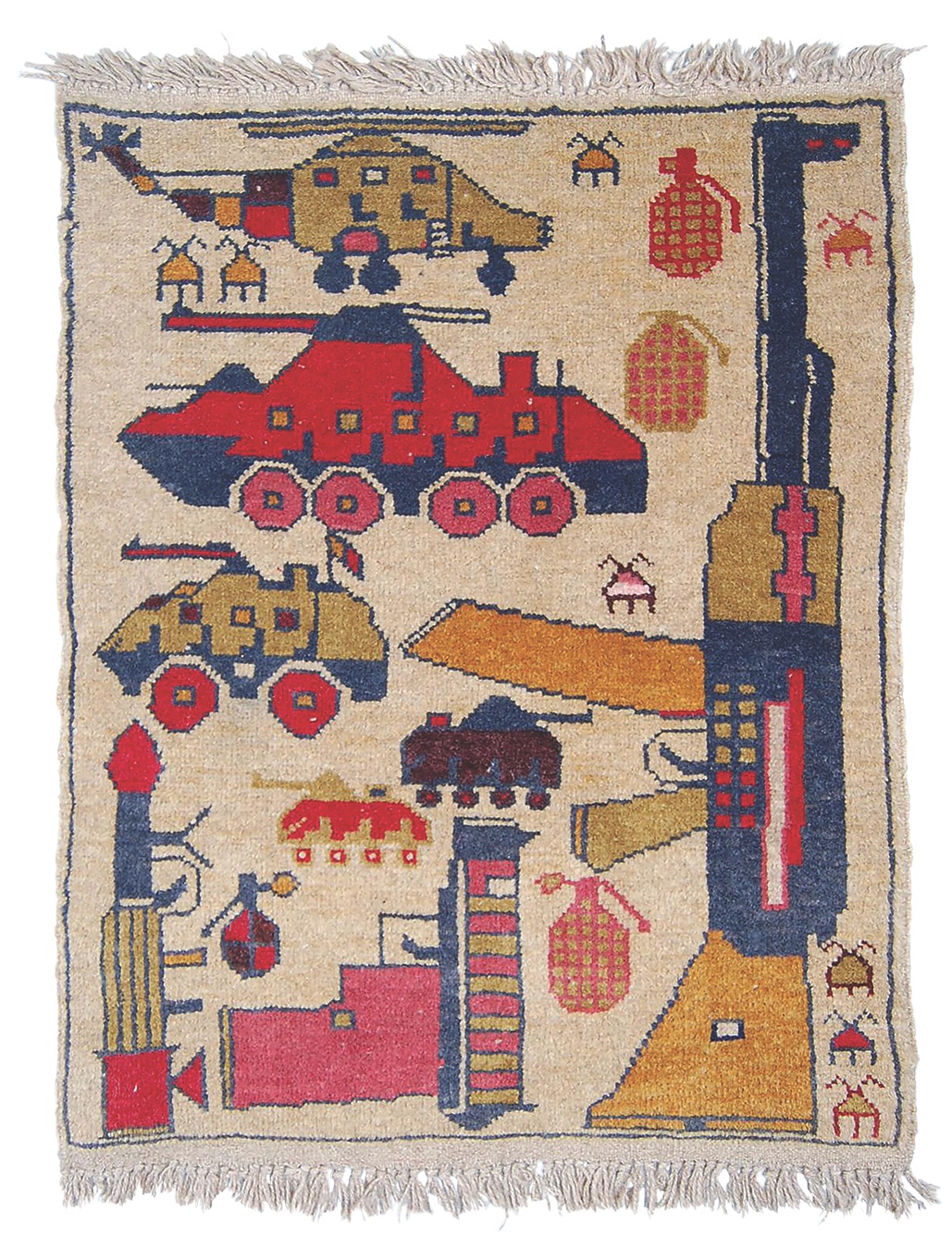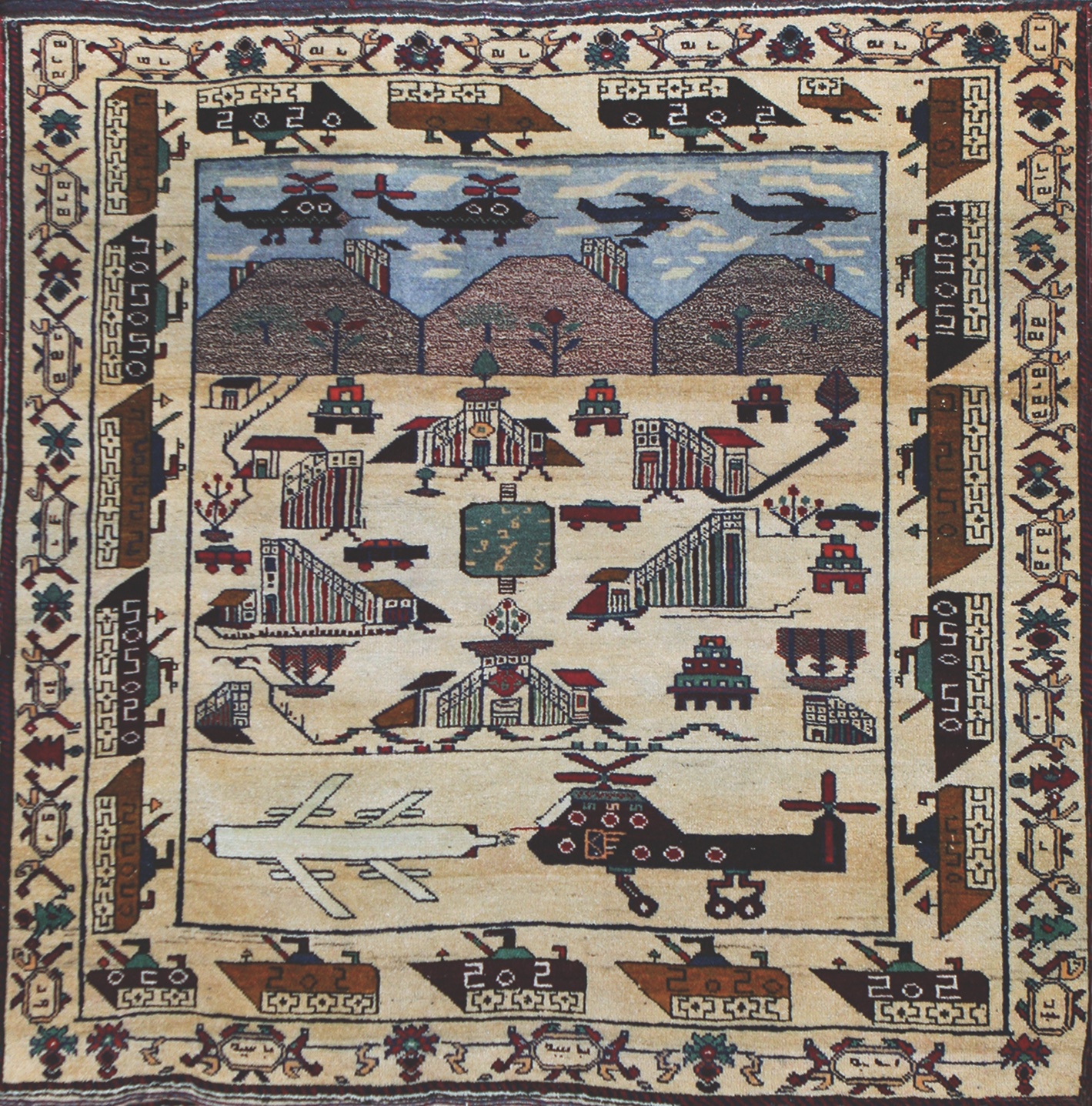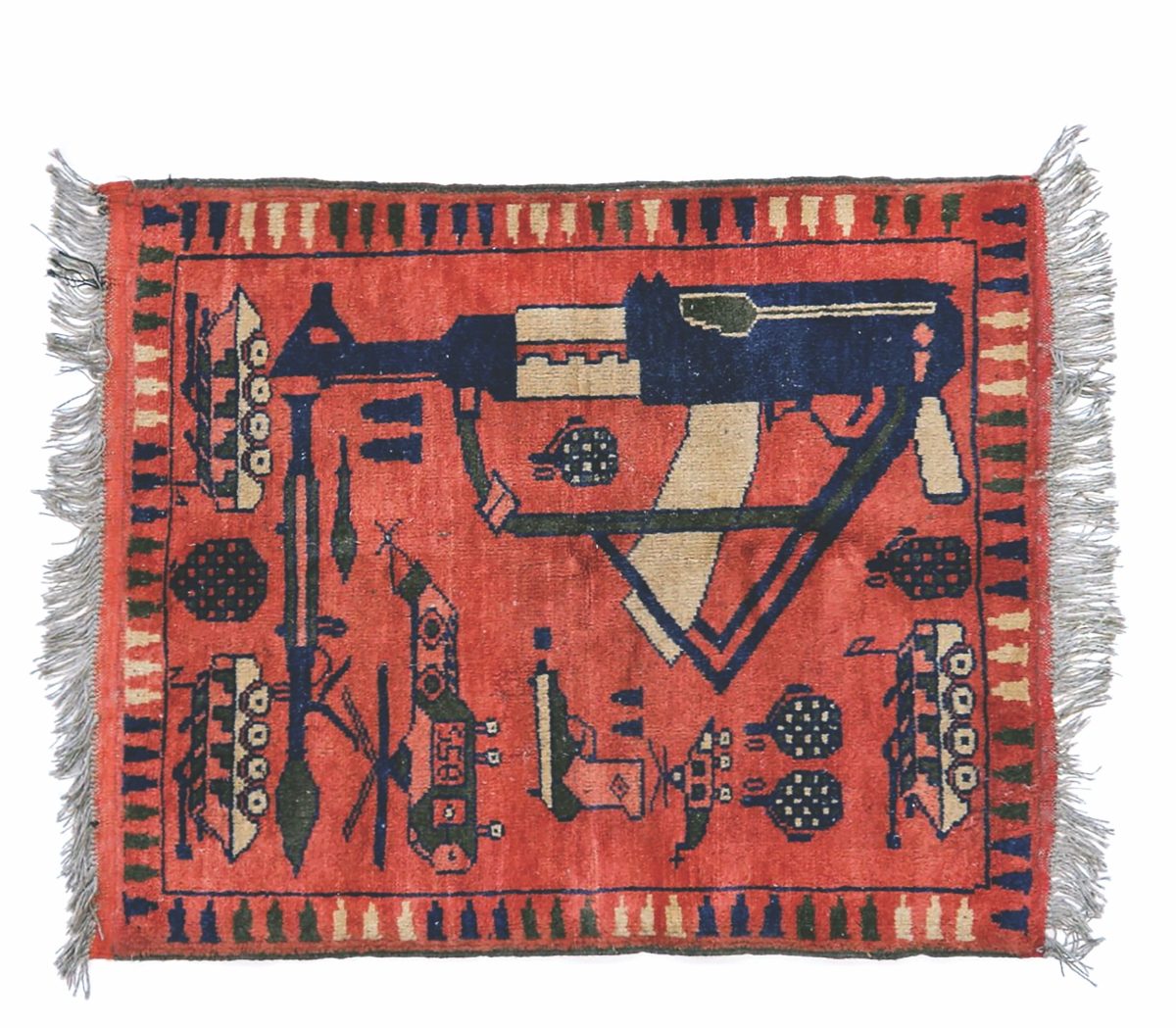When the Soviet Union invaded Afghanistan on December 24, 1979, it brought modern weapons to a region that was already torn by civil war, transforming not only the nature of that war but the imagery of one of the country’s traditional arts.
In 1978, a faction of Afghanistan’s Communist Party had seized power after a long period of internal unrest. Faced with armed resistance from the country’s traditional Islamic population, leaders of the new government turned to the Soviets for help. The help, however, did not take the form they expected. The Soviets, fearing loss of influence in the region, invaded Afghanistan, overthrew its homegrown Communist government, and installed the leader of a faction of the Marxist People’s Democratic Party as the head of a new government.

The Soviets and their new client state met with renewed resistance from the country’s traditional Islamic population. Islamic freedom fighters, known collectively as the mujahideen, used their familiarity with rough mountain terrain and their long tradition of guerrilla warfare against foreign invaders to successfully harass the Soviet forces, at first using weapons seized from the British in the Third Anglo-Afghan War of 1919 and later with weapons taken from the Soviet invaders.
The conflict settled into a stalemate that lasted until 1987, when the U.S. government surreptitiously supplied the mujahideen with FIM-92 Stinger antiaircraft missiles. The mujahideen used these simple, shoulder-launched heat-seeking missiles to shoot down low-flying airplanes and the combat helicopters that were the Red Army’s most effective weapon against the guerrillas. The Soviets began withdrawing from Afghanistan a year later, and the last Soviet soldiers left the country on February 15, 1989.
Nine years of brutal warfare came at a high cost for both sides. An estimated one million Afghan civilians were killed, as well as 90,000 mujahideen, 18,000 Afghan troops, and 15,000 Soviet soldiers. Millions of Afghan civilians fled to refugee camps in neighboring countries.
The Soviet retreat did not end the violence. Civil war between the Afghan army and the mujahideen continued through the 1990s, setting the stage not only for the Taliban’s takeover of the country in 1996 but also for a new generation of foreign invaders.
The Soviet invasion and its aftermath led to continuing political unrest and economic instability in the region, but it also inspired an unusual art form: the Afghan war rug.
The Afghan war rug is a modern adaptation of a traditional art form. Created by women working from their rural homes or in small urban workshops, traditional Afghan rugs are often described as tribal rugs, as opposed to what most people think of as Persian rugs (technically, commercial or city rugs), which are more elaborate in design, often more finely woven, and often quite large, intended to cover the floor of a room.
Afghan rug designs, unlike those of Persian rugs, are more geometric than floral and have more open space. One or more borders surround either a field with a central medallion or a repeated geometric pattern, usually on a dark red background. Prayer rugs often include a niche at one end of the carpet, representing a mihrab—the niche in the wall of a mosque that points toward Mecca. The elements in all of these design types are symmetrically arranged around a central axis.
Modern weapons, most notably military airplanes, appeared on Afghan rugs as early as the 1930s, well before the Soviet invasion, but they were a rarity. It was not until the guerrilla warfare of the 1980s that a growing number of Afghan weavers began to create rugs that combined traditional designs with new motifs and contemporary subject matter, known in Afghanistan as Kalashnikovs, after the Soviet automatic rifles that are a common thematic element in the designs of these rugs.
The makers of Afghan war rugs use the traditional methods and materials of their craft to depict the experience of modern warfare—or at least the weapons with which it is waged. (Enrico Mascelloni, an expert in Central Asian art who curated some of the first exhibitions of Afghan war rugs, describes the rugs as looking like a “weapons catalogue; the rich assortment accumulated in secret warehouses.”)
The design elements of these war rugs are mostly traditional as well. Decorative borders enclose a field of repeating patterns along a strong central axis, but within that structure tanks, helicopters, bombers, Kalashnikov rifles, and hand grenades replace or are intermingled with traditional motifs. With only slight modifications the boteh shape (the dominant element in the pattern known in the West as paisley) became a hand grenade or a helicopter. The octagonal medallions known as göls were easily turned into stylized tanks, with rows of decorative diamonds or stars as their treads. Like traditional göls, these tank-göls are often aligned in a repeated pattern running the length of the central field within a rug’s borders—a rug with two central rows of five tanks, for example, is described as a “10-tank” rug. Set in the context of tanks, traditional star and flower motifs denote explosions. Automatic rifles and highly abstracted airplanes, laid end to end, serve as the rug’s borders or as a central geometric pattern.
Picture rugs, which center on simplified but recognizable images that illustrate an event, are a less common variation of war rug. They are less clearly related to traditional rugs in their imagery, though their makers use the same technique of weaving knots on a loomed foundation of warp and weft. Before the rise of the Taliban, which imposed an extreme version of Islamic law, including a strict prohibition on representing human beings in any medium, some picture rugs included highly stylized portraits of Afghan military and political leaders and images of heroic mujahideen attacking Soviet tanks. Others documented the Soviet exodus from the country by placing an abstracted map of Afghanistan in the central field of the rug, surrounded by images of weapons and vehicles.
Another variant, which is similar in style to the map rugs, features a large-scale image of a single weapon, generally an AK-47 or a Stinger missile, within a traditional border. As in the map rugs, smaller images of other weapons are arranged around the central image. Some of the most dramatic examples of picture rugs depict mosques or other buildings surrounded by helicopters. These are generally described as depicting mosques under attack by Soviet combat helicopters.

The iconography of war rugs has evolved since the 1980s to reflect changes in Afghanistan’s experience of modern warfare. When Stingers became a status symbol for guerrilla units after 1986, they became a popular addition to the “weapons catalogue” depicted on the rugs. When the United States invaded the country in 2001, F-16 fighter jets and M1 Abrams tanks replaced images associated with the Soviet invasion. Rug makers also found inspiration in propaganda leaflets dropped by U.S. military aircraft, incorporating images like the American flag and even words and phrases—often misspelled—such as “hand bom,” “rooket,” Pepsi, rout of terrorism, and U.S.A. Weavers have also produced more controversial rugs inspired by the 9/11 attacks on the Twin Towers in New York, which dealers describe as “War on Terror rugs,” though the imagery is at best ambiguous.
War rugs are the creation of a population that seldom has a voice in public discourse on war and power. The weavers are mostly poor, often illiterate, women, who have learned skills passed down from generations of mothers and daughters before them. (In the years when Afghan refugees poured into camps in Pakistan, some men tried to earn a living weaving rugs.) The weavers of war rugs do not celebrate victories, honor the dead, or criticize policies that plunged their country into war—all common to other forms of war-related art. Instead, working within the limits of the medium and those imposed by Islamic aniconism, their vision is necessarily abstract and geometric, and it’s generally focused on weapons rather than the soldiers who wield them.
Rug dealers and art critics are not sure what first inspired people to create such rugs. Most rugs created over the past 40 years in the home workshops of Afghan families and sold in markets, locally and in Iran and Pakistan, are traditional in every sense of the word. If they were intended for sale, rather than made as a personal statement, the first war rugs would have been a tremendous gamble for their creators, requiring a serious investment of time and money to create a rug with no guaranteed market. Today, the main market for war rugs is outside Afghanistan, where they are part of a larger conversation about war in that country and the troubled relationships between the West and the Islamic world. They are a tangible reminder of the latest chapter in Afghanistan’s long history of resistance to foreign invaders. MHQ
Pamela D. Toler writes about history and the arts. She is the author of several books, including Women Warriors: An Unexpected History (Beacon Press, 2019).





